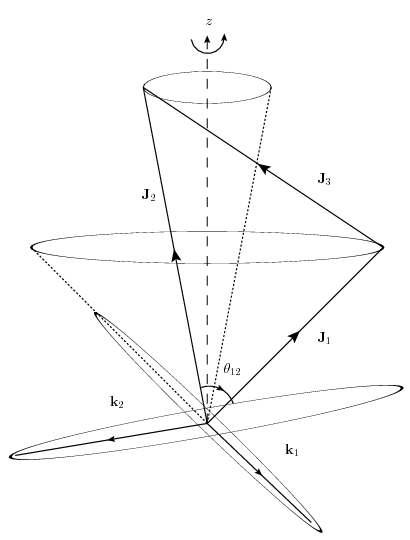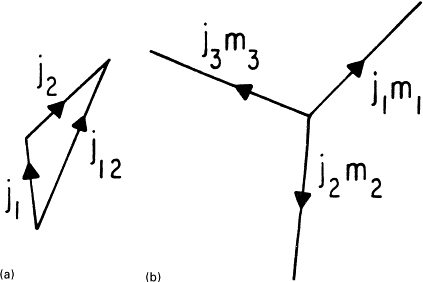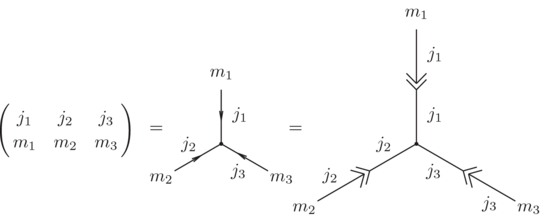LOG#099. Group theory(XIX).
Posted: 2013/04/23 Filed under: Group Theory: basics, Physmatics | Tags: addition of angular momentum, angular momentum, angular momentum composition, Clebsch-Gordan coefficients, group theory, irreducible tensor operator, ITO, Quantum Mechanics, reduced matrix element, scalar operator, selection rules, vector operator, Wigner-Eckart theorem Leave a commentFinal post of this series!
The topics are the composition of different angular momenta and something called irreducible tensor operators (ITO).
Imagine some system with two “components”, e.g., two non identical particles. The corresponding angular momentum operators are:
The following operators are defined for the whole composite system:
These operators are well enough to treat the addition of angular momentum: the sum of two angular momentum operators is always decomposable. A good complete set of vectors can be built with the so-called tensor product:
This basis could NOT be an basis of eigenvectors for the total angular momentum operators
. However, these vector ARE simultaneous eigenvectors for the operators:
The eigenvalues are, respectively,
Examples of compositions of angular momentum operators are:
i) An electron in the hydrogen atom. You have with
. In this case, the invariant hamiltonian under the rotation group for this system must satisfy
ii) N particles without spin. The angular momentum is
iii) Two particles with spin in 3D. The total angular momentum is the sum of the orbital part plus the spin part, as we have already seen:
iv) Two particles with spin in 0D! The total angular momentum is equal to the spin angular momentum, that is,
In fact, the operators commute to each other (they are said to be mutually compatible) and it shows that we can find a common set of eigenstates
The eigenstates of , with eigenvalues
and
are denoted by
and where is an additional set of “quantum numbers”.
The space generated by , for a fixed number
, and
vectors,
, is an invariant subspace and it is also irreducible from the group theory viewpoint. That is, if we find a vector as a linear combination of eigenstates of a single particle, the remaining vectors can be built in the same way.
The vectors can be written as a linear combination of those
. But the point is that, due to the fact that the first set of vectors are eigenstates of
, then we can restrict the search for linear combinations in the vector space with dimension
formed by the vectors
with fixed
quantum numbers. The next theorem is fundamental:
Theorem (Addition of angular momentum in Quantum Mechanics).
Define two angular momentum operators . Define the subspace, with
dimensions and
, formed by the vectors
and where the (quantum) numbers are fixed, while the (quantum) numbers
are “variable”. Let us also define the operators
and
with respective eigenvalues
. Then:
(1) The only values that J can take in this subspace are
(2) To every value of the number J corresponds one and only one set or series of common eigenvectors to
, and these eigenvector are denoted by
.
Some examples:
i) Two spin 1/2 particles. . Then
(in units of
). Moreover, as a subspaces/total space:
ii) Orbital plus spin angular momentum of spin 1/2 particles. In this case, . As subspaces/total space decomposition we have
if
if
iii) Orbital plus two spin parts. . Then, we have
This last subspace sum is equal to if
and it is equal to
if
.
In the case we have to add several (more than two) angular momentum operators, we habe the following general rule…
We should perform the composition or addition taking invariant subspaces two by two and using the previous theorem. However, the theory of the addition of angular momentum in the case of more than 2 terms is more complicated. In fact, the number of times that a particular subspace appears could not be ONE. A simple example is provided by 2 non identical particles (2 nucleons, a proton and a neutron), and in this case the total angular momentum with respect to the center of masses and the spin angular momentum add to form . Then
This subspace sum is equal to if
and
if
.
Clebsch-Gordan coefficients.
We have studied two different set of vectors and bases of eigentstates
(1) , the common set of eigenstates to
.
(2) , the common set of eigenstates to
.
We can relate both sets! The procedure is conceptually (but not analytically, sometimes) simple:
The coefficients:
are called Clebsch-Gordan coefficients. Moreover, we can also expand the above vectors as follows
and here the coefficients
are the inverse Clebsch-Gordan coefficients.
The Clebsch-Gordan coefficients have some beautiful features:
(1) The relative phases are not determined due to the phases in . They do depend on some coefficients
. For any value of J, the phase is determined by recurrence! It shows that
This convention implies that the Clebsch-Gordan (CG) coefficients are real numbers and they form an orthogonal matrix!
(2) Selection rules. The CG coefficients are necessarily null IF the following conditions are NOT satisfied:
i) .
ii)
iii)
The conditions i) and ii) are trivial. The condition iii) can be obtained from a rotation to the previous conditions. The two factors that arise are:
(3) Orthogonality.
(4) Minimal/Maximal CG coefficients.
In the case take their minimal/maximal values, the CG are equal to ONE. Check:
(5) Recurrence relations.
5A) First recurrence:
5B) Second recurrence:
These relations 5A) and 5B) are obtained if we apply the ladder operators in both sides of the equation defining the CG coefficients and using that
Irreducible tensor operators. Wigner-Eckart theorem.
There are 4 important previous definitions for this topic:
1st. Irreducible Tensor Operator (ITO).
We define operators
, with
the standard components of an irreducible tensor operator (ITO) of order
,
, if these components transform according to the following rules
2nd. Irreducible Tensor Operator (II): commutators.
The operators
,
, are the components of an irreducible tensor operator (ITO) of order k,
, if these components satisfy the commutation rules
The 1st and the 2nd definitions are completely equivalent, since the 2nd is the “infinitesimal” version of the 1st. The proof is trivial, by expansion of the operators in series and identification of the involved terms.
3rd. Scalar Operator (SO).
We say that is an scalar operator, if it is an ITO with order k=0. Equivalently,
One simple way to express this result is the obvious and natural statement that scalar operators are rotationally invariant!
4th. Vector Operator (VO).
We say that is a vector operator if
Equivalently, a vector operator is an ITO of order k=1.
The relation between the “standard components” (or “spherical”) and the “cartesian” (i.e.”rectangular”) components is defined by the equations:
In particular, for the position operator , this yields
Similarly, we can define the components for the momentum operator
or the angular momentum
Now, two questions arise naturally:
1) Consider a set of operators, built from ITO
. Are they ITO too? If not, can they be decomposed into ITO?
2) Consider a set of vectors, built from certain ITO, and a given base of eigenvalues for the angular momentum. Are these vectors an invariant set? Are these vectors an irreducible invariant set? If not, can these vectors be decomposed into irreducible, invariant sets for certain angular momentum operators?
Some theorems help to answer these important questions:
Theorem 1. Consider , two irreducible tensor operators with
and
. Take
and
arbitrary. Define the quantity
Then, the operators are the “standard” components of certain ITO with order
. Moreover, we have, using the CG coefficientes:
Theorem 2. Let be certain ITO and
a set of
eigenvectors of angular momentum. Let us define
These vectors are eigenvectors of the TOTAL angular momentum:
Note that, generally, these eigenstates are NOT normalized to the unit, but their moduli do not depend on . Moreover, using the CG coefficients, we algo get
Theorem 3 (Wigner-Eckart theorem).
If is an ITO and some bases for angular momentum are provided with
and
, then
and where the quantity
is called the reduced matrix element. The proof of this theorem is based on (4) main steps:
1st. Use the vectors (varying
),
.
2nd. Form the linear combination/superposition
and use the theorem (2) above to obtain
3rd. Use the CG coefficients and their properties to rewrite the vectors in the base with J and M. Then, irrespectively the form of the ITO, we obtain
4th. Project onto some other different state, we get the desired result
or equivalently
i.e.,
Q.E.D.
The Wigner-Eckart theorem allows us to determine the so-called selection rules. If you have certain ITO and two bases and
, then we can easily prove from the Wigner-Eckart theorem that
(1) If , then
.
(2) If does NOT hold, then
.
These (selection) rules must be satisfied if some transitions are going to “occur”. There are some “superselection” rules in Quantum Mechanics, an important topic indeed, related to issues like this and symmetry, but this is not the thread where I am going to discuss it! So, stay tuned!
I wish you have enjoyed my basic lectures on group theory!!! Some day I will include more advanced topics, I promise, but you will have to wait with patience, a quality that every scientist should own! 🙂
See you in my next (special) blog post ( number 100!!!!!!!!).





You must be logged in to post a comment.